Dzintra Kažoka is energised by her work with students
To recognise outstanding medical personalities for their contribution in the field of medicine, on 9 February 2018 the Latvian Medical Association presented the Annual Medicine Awards. Assoc. Prof. Dzintra Kažoka from Rīga Stradiņš University (RSU) Institute of Anatomy and Anthropology, Department of Morphology was recognised as Medical Lecturer of the Year.
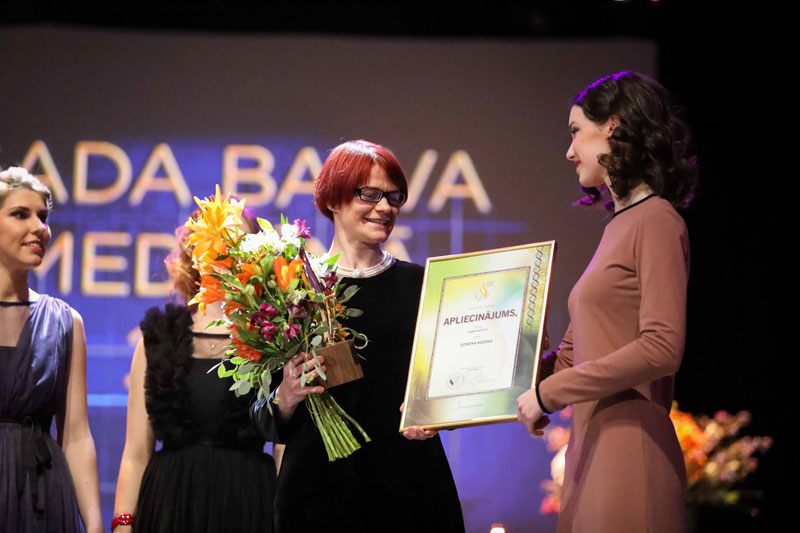
On 9 February in the Ziemeļblāzma Culture Palace Assoc. Prof. Dzintra Kažoka received the award of Medical Lecturer of the Year. Photo from the Latvian Medical Association archive.
Dzintra Kažoka teaches anatomy to prospective medical practitioners, physiotherapists, dentists, nurses, nutrition specialists and pharmacists. “I have devoted practically 19 years to teaching anatomy and I am grateful to my destiny for giving me this opportunity to share my knowledge with students," Dzintra Kažoka is proud of working at RSU.
In addition to supervising students’ scientific research and performing other responsibilities of a RSU lecturer, every May, together with Head of the Department of Morphology, Prof. Māra Pilmane and colleagues from the anatomical theatre (Institute of Anatomy and Anthropology), she organises the anatomy competition The Titans of Anatomy where 2nd year and a number of senior year medical students test the knowledge in anatomy of freshmen in various interactive and active forms.
In order to provide RSU medical and healthcare students with a state-of-the-art study process and to provide proper training for work in the healthcare establishments of Latvia which already use 3D models, Dzintra Kažoka, together with lecturer of the Department of Morphology Andris Čakstiņš, are working on a new study subject on 3D modelling and printing of anatomical structures which will allow students to shape and print bones and organs etc. and learn anatomy through modelling.
What would you describe as the most difficult part of learning anatomy?
The most complicated thing is to understand the proper way of learning and the amount of information to be mastered for gaining the necessary knowledge to meet the requirements of the study subject. At times, the most difficult thing is absorbing the huge amount of information and to identify the most suitable means for efficient acquisition of the required anatomy knowledge.
Another vital aspect are the learning habits of each student. Sometimes I have to help them draw a learning pattern – demonstrate various approaches to learning and also the methods for acquiring, summarising and analysing of information. It must be continued until the student discovers the learning pattern or system that is most suitable for them.
Are modern technologies useful in studying anatomy?
They are both – useful and obstructive. The huge amount of information is a hindrance. As I already mentioned, for a student not to get lost in the vast amount of information available, he must know precisely what to look for. Moreover, it is not good if his only tools are a mobile phone and a computer, as every prospective medical practitioner and healthcare specialist must see what is happening around them and communicate with their fellow students and lecturers. The students must learn how to communicate.
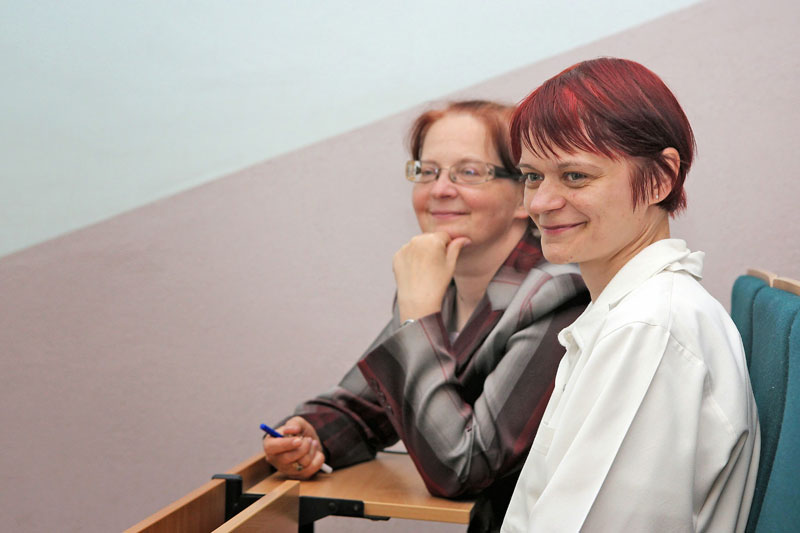 RSU Lecturer of the Department of Morphology Dzintra Kažoka (on the right) and Head of the Institute of Anatomy and Anthropology Māra Pilmane at the 9th Anatomical Competition The Titans of Anatomy, 24 May 2012
RSU Lecturer of the Department of Morphology Dzintra Kažoka (on the right) and Head of the Institute of Anatomy and Anthropology Māra Pilmane at the 9th Anatomical Competition The Titans of Anatomy, 24 May 2012
You have been lecturing at RSU since 1999 – moving on the path from senior laboratory assistant to associate professor. What was the beginning of your pedagogical work like?
In the beginning the most important thing for me was to understand how to address the audience and how to teach. I had to think of how to structure the study material for it to be comprehensible and easily understood by students. I permanently tracked the reaction of students and their comprehension of the study material, and depending on the reaction, I changed and supplemented the contents of my lectures and classes. It was an extreme challenge for me! The experience of organising the study work to attain the most efficient result possible came only with time. I learned from my colleagues, I sat in on their lectures and classes – it was and still is a constant development path.
What is the hardest thing in a lecturer’s work?
That there is not enough time in 24 hours, as you have to constantly prepare for lectures and classes, evaluate students’ papers and learn yourself. Being a lecturer is a very dynamic process.
What gives you satisfaction?
That I have good students who will be our future doctors. It gives me great satisfaction to see them develop. I get particularly emotional at the graduation ceremony when I see that the freshmen who studied anatomy with me have turned into amazing young medical specialists.
What do you expect from students?
I expect progress and advancement - for them not to stand on the spot, use their knowledge for their development, pursuing their dream of becoming a medical practitioner!
What kind of a student would you characterise as a “good student”?
I do not separate them into good or bad students! They are all good students, some need more assistance, some advice, but they are all good.
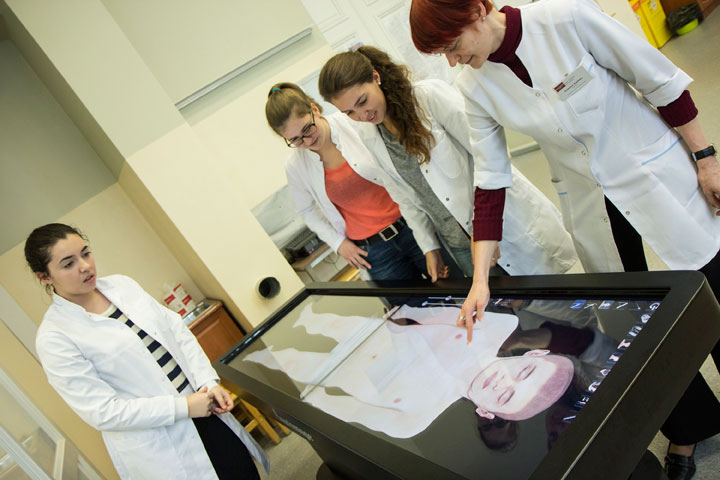
Dzintra Kažoka (first on the right) gives a lecture to international students using the recently-acquired virtual dissection table, 12 February, 2016
In 1999 you graduated from RSU (Medical Academy of Latvia) Faculty of Medicine. What are your memories of the study years?
Study years are the best! Studying - it is not only about learning, but also about making new acquaintances, making friends and enjoying various extra-curricular activities. We were a very friendly study group – we visited each other, participated in hay harvesting, held joint midsummer and Christmas celebrations, went to the theatre etc.
Why did you choose the Medical Academy of Latvia (currently - RSU) and become an academician at RSU?
My mother’s father was a veterinarian but my father’s father healed people with powerful words, so I already had a connection with medical treatment from my childhood. It was my dream to become a physician. I always liked to help others, take care of others, give advice or share knowledge to make someone feel better and consequently – be happy.
As I knew that I want to become a medical practitioner, I took in-depth courses in biology and chemistry at school. The chemistry teacher at Riga Secondary School No. 77 named after Kārlis Videnieks (now called Rīga Avotu Primary School) worked with me after class, preparing me for my medical studies.
When I was already a 6th year student in the Medical Academy, together with my classmates we visited our former anatomy teacher at the Anatomical Theatre who asked if one of us would be willing to work with students. I thought that I should give it a try myself, although at that point I had already decided to devote my life to laboratory and forensic medicine, however there were no real offers that I was willing to take and I did not want to remain without a job for a year. The day after graduation I started to gather the necessary papers to apply for work at the Anatomical Theatre and in September I already stood at the front of the lecture hall. If I had to make the choice again, I would certainly repeat it.
What about the interest in forensic medicine?
I had a deep interest in anatomy, pathological anatomy and in working with microscopes. Some of my colleagues and I, we used to remain after classes to participate in dissection. I liked to study, explore and compare standards with pathologies. I had excellent teachers - Prof. Genovefa Jēča, lecturers Ausma Bērziņa and Aina Visocka and others. Their teaching diagrams are still perfectly suited to the teaching of anatomy to my students.
To which of your teachers would you be willing to present the Medical Lecturer of the Year award and why?
I do not want to mark out someone specific as every one of them has contributed to my development to a greater or lesser extent. I would give the award to all of them.
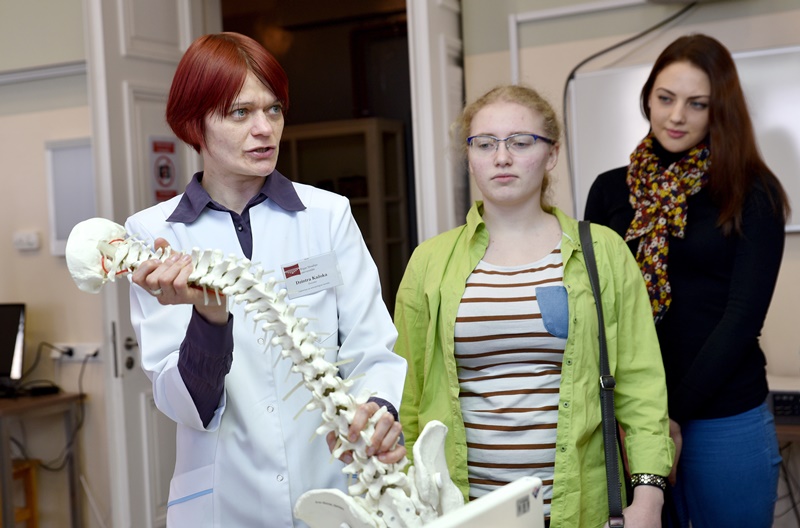
2 April 2016, RSU Open Day, Dzintra Kažoka gives a lecture to prospective students and their parents at the Anatomical Theatre
Would you agree that we tend to remember strict and demanding teachers more?
Certainly, but this is not always so! You also remember those teachers who devote their time to speak to a student, to understand the study aspects that are hard to master, what causes problems and what helps. As medicine is something you just need to know and no mistakes are allowed, it is good to have strict lecturers whose strict study requirements contribute to students avoiding certain mistakes afterwards. To make mistakes less while already practicing medicine, you have to study hard while you are a student.
How would you describe a good lecturer?
A good lecturer is someone who combines strictness with a positive attitude towards students. It is someone who knows how to listen and understand. A good lecturer is a multitasker – a producer, a teacher and a medical practitioner at the same time!
A good lecturer is someone who also constantly learns from the students. They are always striving to improve themselves. Whether you are a good lecturer – is up to others to decide – those who see your work daily. For example with this Medical Lecturer of the Year award nothing stops, I continue on my way. You have to strive for constant development, learn, and follow the latest technological advancements and be state of the art in your field and equally also in other areas of science.
What things do you find difficult to understand?
Negligence and carelessness towards other people, their work, towards the time and effort they have invested in something, for example, when students do not listen to what I say, chat among themselves. I do not like dishonest students who use various crooked and forbidden ways and means.
What is your source of energy?
Students! No matter how tired I am, when I enter the lecture room I receive positive energy from my students. They give me strength! Also colleagues, books, walks, fresh air, sport, dancing and travelling where I can see new places, meet interesting people, learn about different cultures.
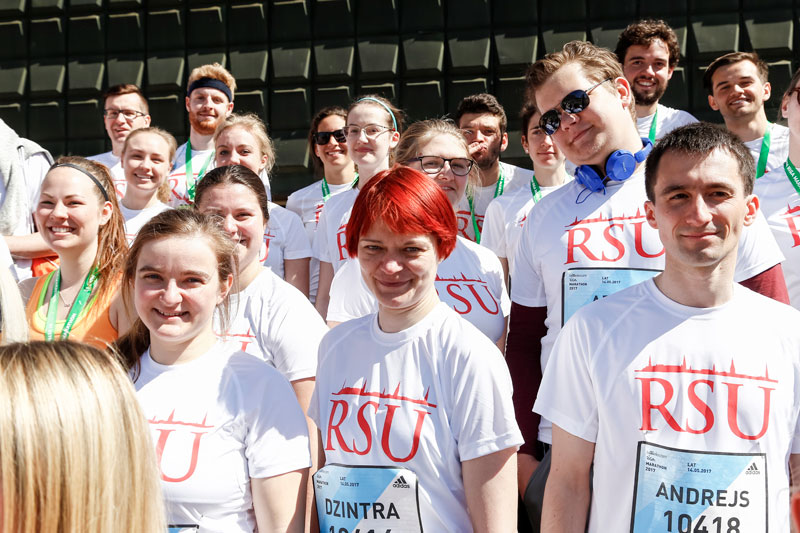 14 May 2017, Assoc. Prof. Dzintra Kažoka participates in the Lattelecom Riga Marathon
14 May 2017, Assoc. Prof. Dzintra Kažoka participates in the Lattelecom Riga Marathon
Is there any book that has made a major impact on your life?
A book of strong impressions was To Fall and Rise by Jānis Greste that I read at school. It demonstrates the ability to get up even if life is not taking a smooth path and to lift others who need your support. I also remember the book by Estonian author Silvia Rannamaa Kadri about the difficult school years of an Estonian girl at the end of the 1850s and in the beginning of the 1860s. I also vividly remember a childhood book Geometry for the Small by V.Žitomirskis and L.Ševrins.
I would also like to mention the historical novel The Egyptian by Mika Waltari. It is about the life, travels and adventures of the priest-physician Sinuhe living in the 14th century B.C. during the reign of the legendary Pharaoh Akhenaten and his queen Nefertiti.
What, in your opinion, is the biggest evil?
I think that it is war – at a national and a personal level. In the field of medicine – tumours and serious illnesses. We cannot help such people and are powerless. I think that famine is also an evil thing.
What are your demands from life?
Health is what matters the most. If an individual is healthy, he can live without much comfort and accomplish a lot!
Related news
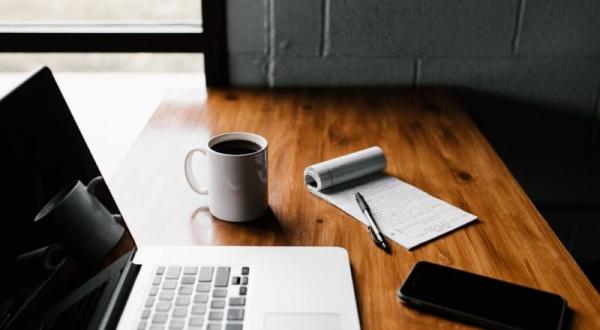 RSU adopts amendments to its Code of Ethics to uphold professional ethics requirementsFor Students, For RSU Employees
RSU adopts amendments to its Code of Ethics to uphold professional ethics requirementsFor Students, For RSU Employees


